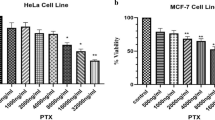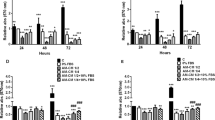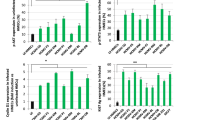Abstract
As human amniotic fluid-derived stem cells (hAFSCs) are capable of multiple lineage differentiation, extensive self-renewal and tumor targeting, they may be valuable for clinical anticancer therapies. In this study, we used hAFSCs as vehicles for targeted delivery of therapeutic suicide genes to breast cancer cells. hAFSCs were engineered to produce AF2.CD-TK cells in order to express two suicide genes encoding bacterial cytosine deaminase (CD) and herpes simplex virus thymidine kinase (HSV-TK) that convert non-toxic prodrugs, 5-fluorocytosine (5-FC) and mono-phosphorylate ganciclovir (GCV-MP), into cytotoxic metabolites, 5-fluorouracil (5-FU) and triphosphate ganciclovir (GCV-TP), respectively. In cell viability test in vitro, AF2.CD-TK cells inhibited the growth of MDA-MB-231 human breast cancer cells in the presence of the 5-FC or GCV prodrugs, or a combination of these two reagents. When the mixture of 5-FC and GCV was treated together, an additive cytotoxic effect was observed in the cell viability. In animal experiments using female BALB/c nude mouse xenografts, which developed by injecting MDA-MB-231 cells, treatment with AF2.CD-TK cells in the presence of 5-FC and GCV significantly reduced tumor volume and weight to the same extent seen in the mice treated with 5-FU. Histopathological and fluorescent staining assays further showed that AF2.CD-TK cells were located exactly at the site of tumor formation. Furthermore, breast tissues treated with AF2.CD-TK cells and two prodrugs maintained their normal structures (for example, the epidermis and reticular layers) while breast tissue structures in 5-FU-treated mice were almost destroyed by the potent cytotoxicity of the drug. Taken together, these results indicate that AF2.CD-TK cells can serve as excellent vehicles in a novel therapeutic cell-based gene-directed prodrug system to selectively target breast malignancies.
This is a preview of subscription content, access via your institution
Access options
Subscribe to this journal
Receive 12 print issues and online access
$259.00 per year
only $21.58 per issue
Buy this article
- Purchase on Springer Link
- Instant access to full article PDF
Prices may be subject to local taxes which are calculated during checkout







Similar content being viewed by others
References
Anderson LM, Krotz S, Weitzman SA, Thimmapaya B . Breast cancer-specific expression of the candida albicans cytosine deaminase gene using a transcriptional targeting approach. Cancer Gene Ther 2000; 7: 845–852.
Myers CE . The pharmacology of the fluoropyrimidines. Pharmacol Rev 1981; 33: 1–15.
Boucher PD, Im MM, Freytag SO, Shewach DS . A novel mechanism of synergistic cytotoxicity with 5-fluorocytosine and ganciclovir in double suicide gene therapy. Cancer Res 2006; 66: 3230–3237.
Rubsam LZ, Davidson BL, Shewach DS . Superior cytotoxicity with ganciclovir compared with acyclovir and 1-beta-D-arabinofuranosylthymine in herpes simplex virus-thymidine kinase-expressing cells: a novel paradigm for cell killing. Cancer Res 1998; 58: 3873–3882.
Tomicic MT, Thust R, Kaina B . Ganciclovir-induced apoptosis in HSV-1 thymidine kinase expressing cells: critical role of DNA breaks, Bcl-2 decline and caspase-9 activation. Oncogene 2002; 21: 2141–2153.
Zhang JF, Wei F, Wang HP, Li HM, Qiu W, Ren PK et al. Potent anti-tumor activity of telomerase-dependent and HSV-TK armed oncolytic adenovirus for non-small cell lung cancer in vitro and in vivo. J Exp Clin Cancer Res 2010; 29: 52.
Tang W, He Y, Zhou S, Ma Y, Liu G . A novel Bifidobacterium infantis-mediated TK/GCV suicide gene therapy system exhibits antitumor activity in a rat model of bladder cancer. J Exp Clin Cancer Res 2009; 28: 155.
Yi C, Huang Y, Guo ZY, Wang SR . Antitumor effect of cytosine deaminase/5-fluorocytosine suicide gene therapy system mediated by Bifidobacterium infantis on melanoma. Acta Pharmacol Sin 2005; 26: 629–634.
Aboody KS, Najbauer J, Schmidt NO, Yang W, Wu JK, Zhuge Y et al. Targeting of melanoma brain metastases using engineered neural stem/progenitor cells. Neuro Oncol 2006; 8: 119–126.
Andersen L, Kilstrup M, Neuhard J . Pyrimidine, purine and nitrogen control of cytosine deaminase synthesis in Escherichia coli K 12. Involvement of the glnLG and purR genes in the regulation of codA expression. Arch Microbiol 1989; 152: 115–118.
Chang DY, Yoo SW, Hong Y, Kim S, Kim SJ, Yoon SH et al. The growth of brain tumors can be suppressed by multiple transplantation of mesenchymal stem cells expressing cytosine deaminase. Int J Cancer 2010; 127: 1975–1983.
Gu C, Li S, Tokuyama T, Yokota N, Namba H . Therapeutic effect of genetically engineered mesenchymal stem cells in rat experimental leptomeningeal glioma model. Cancer Lett 2010; 291: 256–262.
Hajitou A, Trepel M, Lilley CE, Soghomonyan S, Alauddin MM, Marini 3rd FC et al. A hybrid vector for ligand-directed tumor targeting and molecular imaging. Cell 2006; 125: 385–398.
Kim SK, Kim SU, Park IH, Bang JH, Aboody KS, Wang KC et al. Human neural stem cells target experimental intracranial medulloblastoma and deliver a therapeutic gene leading to tumor regression. Clin Cancer Res 2006; 12: 5550–5556.
Kucerova L, Altanerova V, Matuskova M, Tyciakova S, Altaner C . Adipose tissue-derived human mesenchymal stem cells mediated prodrug cancer gene therapy. Cancer Res 2007; 67: 6304–6313.
Lee DH, Ahn Y, Kim SU, Wang KC, Cho BK, Phi JH et al. Targeting rat brainstem glioma using human neural stem cells and human mesenchymal stem cells. Clin Cancer Res 2009; 15: 4925–4934.
Kang NH, Yi BR, Lim SY, Hwang KA, Baek YS, Kang KS et al. Human amniotic membrane-derived epithelial stem cells display anticancer activity in BALB/c female nude mice bearing disseminated breast cancer xenografts. Int J Oncol 2012 (in press).
De Coppi P, Bartsch Jr G, Siddiqui MM, Xu T, Santos CC, Perin L et al. Isolation of amniotic stem cell lines with potential for therapy. Nat Biotechnol 2007; 25: 100–106.
Phermthai T, Odglun Y, Julavijitphong S, Titapant V, Chuenwattana P, Vantanasiri C et al. A novel method to derive amniotic fluid stem cells for therapeutic purposes. BMC Cell Biol 2010; 11: 79.
Tamagawa T, Ishiwata I, Nakamura Y . Differentiation of human amniotic membrane cells into osteoblasts in vitro. Hum Cell 2005; 18: 191–195.
Zhang X, Chen X, Wang H, Liu S . [Development of amniotic fluid-derived stem cell]. Zhongguo Xiu Fu Chong Jian Wai Ke Za Zhi 2008; 22: 864–868.
Kim KY, Yi BR, Lee HR, Kang NH, Jeung EB, Kim SU et al. Stem cells with fused gene expression of cytosine deaminase and interferon-beta migrate to human gastric cancer cells and result in synergistic growth inhibition for potential therapeutic use. Int J Oncol 2012; 40: 1097–1104.
Yi BR, Hwang KA, Kang NH, Kim SU, Jeung EB, Choi KC . Antitumor therapeutic effects of cytosine deaminase and interferon-beta against endometrial cancer cells using genetically engineered stem cells in vitro. Anticancer Res 2011; 31: 2853–2862.
Yi BR, O SN, Kang NH, Hwang KA, Kim SU, Jeung EB et al. Genetically engineered stem cells expressing cytosine deaminase and interferon-beta migrate to human lung cancer cells and have potentially therapeutic anti-tumor effects. Int J Oncol 2011; 39: 833–839.
Agyin JK, Santhamma B, Nair HB, Roy SS, Tekmal RR . BU-32: a novel proteasome inhibitor for breast cancer. Breast Cancer Res 2009; 11: R74.
Peterson SM, Iskenderian A, Cook L, Romashko A, Tobin K, Jones M et al. Human sulfatase 2 inhibits in vivo tumor growth of MDA-MB-231 human breast cancer xenografts. BMC Cancer 2010; 10: 427.
Aboody KS, Bush RA, Garcia E, Metz MZ, Najbauer J, Justus KA et al. Development of a tumor-selective approach to treat metastatic cancer. PLoS One 2006; 1: e23.
Longley DB, Harkin DP, Johnston PG . 5-Fluorouracil: mechanisms of action and clinical strategies. Nat Rev Cancer 2003; 3: 330–338.
Fidan E, Fidan S, Yildiz B, Durmus I, Kavgaci H, Ozdemir F et al. Bolus fluorouracil induced syncope and pulseless ventricular tachycardia: a case report. Hippokratia 2011; 15: 93–95.
Bi WL, Parysek LM, Warnick R, Stambrook PJ . In vitro evidence that metabolic cooperation is responsible for the bystander effect observed with HSV tk retroviral gene therapy. Hum Gene Ther 1993; 4: 725–731.
Ishii-Morita H, Agbaria R, Mullen CA, Hirano H, Koeplin DA, Ram Z et al. Mechanism of ‘bystander effect’ killing in the herpes simplex thymidine kinase gene therapy model of cancer treatment. Gene Ther 1997; 4: 244–251.
Aghi M, Kramm CM, Chou TC, Breakefield XO, Chiocca EA . Synergistic anticancer effects of ganciclovir/thymidine kinase and 5-fluorocytosine/cytosine deaminase gene therapies. J Natl Cancer Inst 1998; 90: 370–380.
Freytag SO, Rogulski KR, Paielli DL, Gilbert JD, Kim JH . A novel three-pronged approach to kill cancer cells selectively: concomitant viral, double suicide gene, and radiotherapy. Hum Gene Ther 1998; 9: 1323–1333.
Uckert W, Kammertöns T, Haack K, Qin Z, Gebert J, Schendel DJ et al. Double suicide gene (cytosine deaminase and herpes simplex virus thymidine kinase) but not single gene transfer allows reliable elimination of tumor cells in vivo. Hum Gene Ther 1998; 9: 855–865.
Kim SU, Jeung EB, Kim YB, Cho MH, Choi KC . Potential tumor-tropic effect of genetically engineered stem cells expressing suicide enzymes to selectively target invasive cancer in animal models. Anticancer Res 2011; 31: 1249–1258.
Acknowledgements
This work was supported by two National Research Foundation of Korea (NRF) grants funded by the Ministry of Education, Science and Technology (MEST) of Korea Government (no. 2010-0003093 and 2011-0015385).
Author information
Authors and Affiliations
Corresponding author
Ethics declarations
Competing interests
The authors declare no conflict of interest.
Rights and permissions
About this article
Cite this article
Kang, NH., Hwang, KA., Yi, BR. et al. Human amniotic fluid-derived stem cells expressing cytosine deaminase and thymidine kinase inhibits the growth of breast cancer cells in cellular and xenograft mouse models. Cancer Gene Ther 19, 412–419 (2012). https://doi.org/10.1038/cgt.2012.15
Received:
Revised:
Accepted:
Published:
Issue Date:
DOI: https://doi.org/10.1038/cgt.2012.15
Keywords
This article is cited by
-
Mesenchymal stem cells and cancer therapy: insights into targeting the tumour vasculature
Cancer Cell International (2021)
-
Combination of MPPa-PDT and HSV1-TK/GCV gene therapy on prostate cancer
Lasers in Medical Science (2018)
-
Combined enzyme/prodrug treatment by genetically engineered AT-MSC exerts synergy and inhibits growth of MDA-MB-231 induced lung metastases
Journal of Experimental & Clinical Cancer Research (2015)
-
Tissue-derived mesenchymal stromal cells used as vehicles for anti-tumor therapy exert different in vivoeffects on migration capacity and tumor growth
BMC Medicine (2013)
-
Anticancer Effects of the Engineered Stem Cells Transduced with Therapeutic Genes via a Selective Tumor Tropism Caused by Vascular Endothelial Growth Factor Toward HeLa Cervical Cancer Cells
Molecules and Cells (2013)



